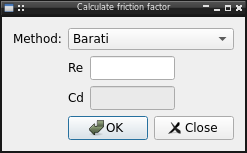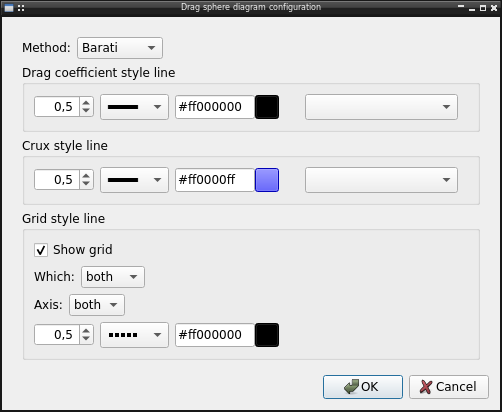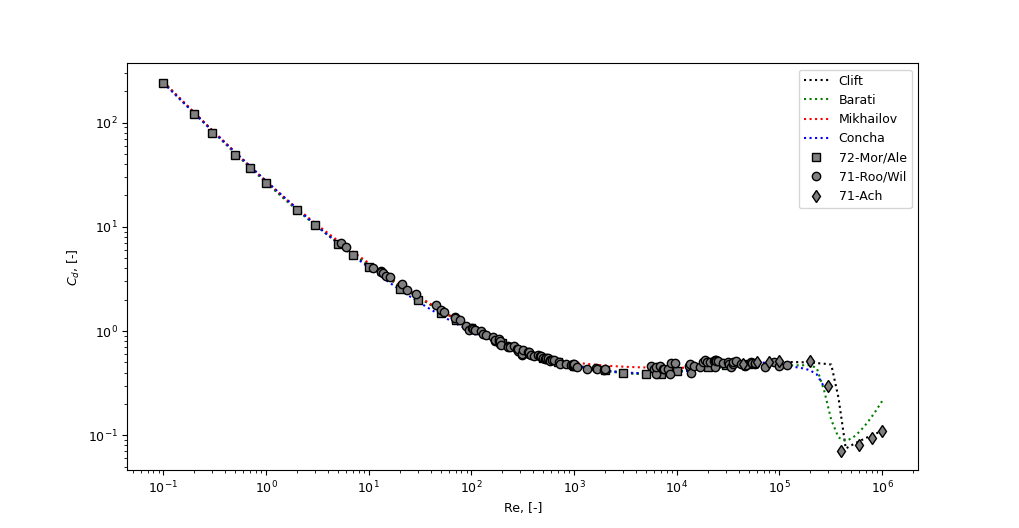lib.drag module¶
Module for drag coefficient correlations, for now only implemented the sphere drag correlation
dragSphere(): Function to implement the drag coeficient for smooth
spheres including all available methods:
Plot the drag coefficiente as function of reynolds number of a sphere.

The diagram include all Reynolds number range, support for click interaction, let user save the chart as image and a dialog to calculate a individual point:

Configuration¶

The diagram let user configure several options like:
Equation to use, by default the Barati correlation, but it’s possible use one of available in lib.drag
Line style used in plot
Line style used in crux when use mouse
Grid line visibility and style
Example¶
Comparing some correlations with experimental data
from matplotlib import pyplot
from numpy import logspace
from lib.drag import Clift, Mikhailov, Concha, Barati
corr = {
Clift: {"c": "black", "ls": ":"},
Barati: {"c": "green", "ls": ":"},
Mikhailov: {"c": "red", "ls": ":"},
Concha: {"c": "blue", "ls": ":"}}
Re = logspace(-1, 6, 100)
for f, kw in corr.items():
Cd = []
for re in Re:
try:
v = f(re)
except NotImplementedError:
v = None
Cd.append(v)
pyplot.plot(Re, Cd, label=f.__name__, **kw)
# Experimental date
# Morsi, S.A., Alexander, A.J.
# An Investigation of Particle Trajectories in Two-Phase Flow Systems
# J. Fluid Mechanics 55(2) (1972) 193-208
# doi: 10.1017/S0022112072001806
Re = [0.1, 0.2, 0.3, 0.5, 0.7, 1, 2, 3, 5, 7, 10, 20, 30, 50, 70, 100, 200,
300, 500, 700, 1000, 2000, 3000, 5000, 7000, 10000, 20000, 30000,
50000]
Cd = [240, 120, 80, 49, 36.5, 26.5, 14.4, 10.4, 6.9, 5.4, 4.1, 2.55, 2, 1.5,
1.27, 1.07, 0.77, 0.65, 0.55, 0.5, 0.46, 0.42, 0.4, 0.385, 0.39, 0.41,
0.452, 0.4697, 0.488]
pyplot.plot(Re, Cd, ls='', marker="s", mec="k", mfc="grey", label="72-Mor/Ale")
# Roos, F.W., Willmarth, W.W.
# Some Experimental Results on Sphere and Disk Drag
# Amer. Inst. Aeronautics and Astronautics 9(2) (1971) 285-291
# doi: 10.2514/3.6164
Re = [5.33, 5.99, 11.0, 13.1, 13.2, 13.9, 14.6, 16.2, 21.1, 23.4, 29.1, 45.0,
50.6, 54.4, 68.9, 68.9, 78.2, 88.1, 93.8, 101, 104, 108, 109, 124, 130,
138, 163, 168, 170, 186, 186, 189, 190, 191, 193, 229, 229, 240, 258,
280, 284, 286, 311, 312, 318, 358, 361, 364, 379, 409, 444, 468, 472,
480, 500, 522, 532, 532, 557, 579, 588, 603, 644, 713, 727, 833, 932,
984, 985, 985, 1000, 1000, 1070, 1330, 1650, 1690, 1950, 2000, 5570,
5990, 6210, 6250, 6900, 7280, 7520, 8230, 8580, 8700, 9620, 13300, 13400,
13900, 14700, 16800, 18000, 18700, 19500, 21200, 23100, 23600, 23700,
24100, 24200, 25000, 28000, 31900, 32400, 33800, 35400, 35500, 38200,
41800, 45900, 46800, 52400, 53500, 57500, 57700, 71900, 89000, 100000,
118300]
Cd = [7.06, 6.41, 4.01, 3.76, 3.66, 3.59, 3.41, 3.29, 2.82, 2.48, 2.28, 1.79,
1.58, 1.52, 1.35, 1.33, 1.27, 1.12, 1.03, 1.08, 1.05, 1.02, 1.03, 0.994,
0.927, 0.907, 0.879, 0.799, 0.819, 0.799, 0.841, 0.778, 0.751, 0.799,
0.732, 0.711, 0.710, 0.700, 0.721, 0.674, 0.646, 0.675, 0.592, 0.607,
0.656, 0.627, 0.600, 0.632, 0.595, 0.579, 0.585, 0.578, 0.566, 0.572,
0.547, 0.544, 0.543, 0.556, 0.552, 0.523, 0.520, 0.531, 0.525, 0.505,
0.480, 0.485, 0.472, 0.466, 0.477, 0.485, 0.472, 0.483, 0.452, 0.436,
0.440, 0.435, 0.427, 0.430, 0.460, 0.430, 0.390, 0.451, 0.460, 0.430,
0.435, 0.429, 0.390, 0.490, 0.490, 0.460, 0.480, 0.400, 0.460, 0.452,
0.510, 0.523, 0.500, 0.509, 0.511, 0.529, 0.455, 0.524, 0.520, 0.519,
0.495, 0.500, 0.479, 0.457, 0.482, 0.504, 0.513, 0.485, 0.467, 0.468,
0.503, 0.497, 0.480, 0.492, 0.451, 0.502, 0.467, 0.476]
pyplot.plot(Re, Cd, ls='', marker="o", mec="k", mfc="grey", label="71-Roo/Wil")
# Achenbach, E.
# Experiments on the Flow Past Spheres at Very High Reynolds Numbers
# J. Fluid Mech. 54(3) (1972) 565-575
# doi: 10.1017/S0022112072000874
# Selected point of figure 4, the paper don't report the experimental data
Re = [4.4e4, 6e4, 8e4, 1e5, 2e5, 3e5, 4e5, 6e5, 8e5, 1e6]
Cd = [0.48, 0.5, 0.51, 0.52, 0.52, 0.3, 0.07, 0.08, 0.095, 0.11]
pyplot.plot(Re, Cd, ls='', marker="d", mec="k", mfc="grey", label="71-Ach")
pyplot.ylabel("$C_d$, [-]")
pyplot.xlabel("Re, [-]")
pyplot.xscale("log")
pyplot.yscale("log")
pyplot.legend()
pyplot.show()

- lib.drag.Barati(Re, extended=False)[source]¶
Calculates drag coefficient of a smooth sphere using the method in [1].
For Re < 2e5
\[\begin{split}\begin{align*} C_d = 5.4856·10^9\tanh(4.3774\times10^{-9}/Re) + 0.0709\tanh(700.6574/Re) \\ {} + 0.3894\tanh(74.1539/Re) - 0.1198\tanh(7429.0843/Re) \\ {} + 1.7174\tanh[9.9851/(Re+2.3384)] + 0.4744 \end{align*}\end{split}\]For 2e5 <= Re < 1e6
\[\begin{split}\begin{align*} C_d = 8·10^{-6}\left[(Re/6530)^2+\tanh(Re) - 8\ln(Re)/\ln(10)\right] \\ {} - 0.4119\exp(-2.08x10^{43}/[Re + Re^2]^4) \\ {} - 2.1344\exp(-{\left[\ln(Re^2 + 10.7563)/\ln(10)\right]^2 + 9.9867}/Re) \\ {} + 0.1357\exp(-[(Re/1620)^2 + 10370]/Re) \\ {} - 8.5\times 10^{-3}\{2\ln[\tanh(\tanh(Re))]/\ln(10) - 2825.7162\}/Re \end{align*}\end{split}\]- Parameters:
- Refloat
Reynolds number of the sphere, [-]
- extendedboolean
Use the extended version on all Re range of equation
- Returns:
- Cdfloat
Drag coefficient [-]
Notes
Raise
NotImplementedErrorif Re isn’t in range Re ≤ 1e6References
[1] Barati, R., Neyshabouri, S.A.A.S, Ahmadi, G.; Development of Empirical Models with High Accuracy for Estimation of Drag Coefficient of Flow around a Smooth Sphere: An Evolutionary Approach. Powder Technology 257 (2014) 11-19
Examples
Selected values from Table 6 in [1].
>>> print("%0.2f" % Barati(0.002)) 12008.86 >>> print("%0.2f" % Barati(0.002, extended=True)) 12034.71 >>> print("%0.2f" % Barati(1000)) 0.47
- lib.drag.Clift(Re)[source]¶
Calculates drag coefficient of a smooth sphere using the method in [2].
This method use different correlation for several ranges of Re, as describe in Table 5.2, pag 112
\[\begin{split}C_d = \left\{ \begin{array}{ll} \frac{24}{Re} + \frac{3}{16} & \mbox{if $Re < 0.01$}\\ \frac{24}{Re}(1 + 0.1315Re^{0.82-0.05w}) & \mbox{if $0.01 < Re < 20$}\\ \frac{24}{Re}(1 + 0.1935Re^{0.6305}) & \mbox{if $20 < Re < 260$}\\ 10^{[1.6435 - 1.1242w + 0.1558w^2} & \mbox{if $260 < Re < 1500$}\\ 10^{[-2.4571 + 2.5558w - 0.9295w^2 + 0.1049w^3} & \mbox{if $1500 < Re < 1.2x10^4$}\\ 10^{[-1.9181 + 0.6370w - 0.0636w^2} & \mbox{if $1.2x10^4 < Re < 4.4x10^4$}\\ 10^{[-4.3390 + 1.5809w - 0.1546w^2} & \mbox{if $4.4x10^4 < Re < 3.38x10^5$}\\ 29.78 - 5.3w & \mbox{if $3.38x10^5 < Re < 4x10^5$}\\ 0.1w - 0.49 & \mbox{if $4x10^5 < Re < 10^6$}\\ 0.19w - \frac{8x10^4}{Re} & \mbox{if $10^6 < Re$}\end{array}\right.\end{split}\]where \(w = \log_{10}{Re}\)
- Parameters:
- Refloat
Reynolds number of the sphere, [-]
- Returns:
- Cdfloat
Drag coefficient [-]
Notes
Raise
NotImplementedErrorif Re isn’t in range Re ≤ 6e6 The last equation is based in Achenbach data and this reach 6e6 as maximum Reynolds numberReferences
[2] Clift, R., Grace, J.R., Weber, M.E.; Bubbles, Drops, and Particles. Academic Press, 1978.
Examples
There isn´t testing values but checking a value similar to Barati correlation would be enough
>>> print("%0.0f" % Clift(0.002)) 12000 >>> print("%0.2f" % Clift(1000)) 0.47
- lib.drag.Ceylan(Re)[source]¶
Calculates drag coefficient of a smooth sphere using the method in [3].
\[\begin{split}\begin{align*} C_d = 1 - 0.5e^{0.182} + 10.11Re^{-2/3}e^{0.952Re^{-1/4}} - 0.03859Re^{-4/3}e^{1.30Re^{-1/2}} \\ {} + 0.037\times10^{-4}Re e^{-0.125\times10^{-4}Re} -0.116\times10^{-10}Re^2 e^{-0.444\times10^{-5}Re} \end{align*}\end{split}\]- Parameters:
- Refloat
Reynolds number of the sphere, [-]
- Returns:
- Cdfloat
Drag coefficient [-]
Notes
Raise
NotImplementedErrorif Re isn’t in range Re ≤ 1e6References
[3] Ceylan, K., Altunbaş, A., Kelbaliyev, G.; A New Model for Estimation of Drag Force in the Flow of Newtonian Fluids around Rigid or Deformable Particles. Powder Technology 119 (2001) 250-56
Examples
Selected values from Table 2, pag 253
# >>> print(“%0.0f” % Ceylan(0.1)) # 238 # >>> print(“%0.2f” % Ceylan(0.5)) # 49.50 # >>> print(“%0.2f” % Ceylan(1e3)) # 0.46
>>> print("%0.2f" % Ceylan(1e6)) 0.26
This correlation dont return the expected vaues in paper for low Reynolds numbers, possible a typo in paper
- lib.drag.Almedeij(Re)[source]¶
Calculates drag coefficient of a smooth sphere using the method in [4].
\[\begin{split}\begin{align*} C_d = \left(\frac{1}{(\phi_1 + \phi_2)^{-1} + (\phi_3)^{-1}} + \phi_4 \right)^{0.1} \\ {} \phi_1 = \left(\frac{24}{Re}\right)^{10} + \left(\frac{21}{Re^{0.67}}\right)^{10} + \left(\frac{4}{Re^{0.33}}\right)^{10} + 0.4^{10} \\ {} \phi_2 = \frac{1}{\left[(0.148 Re^{0.11})^{-10} + (0.5)^{-10}\right]} \\ {} \phi_3 = \left(\frac{1.57x10^8} {Re^{1.625}}\right)^{10} \\ {} \phi_4 = \frac{1}{(6x10^{-17}Re^{2.63})^{-10} + (0.2)^{-10}} \end{align*}\end{split}\]- Parameters:
- Refloat
Reynolds number of the sphere, [-]
- Returns:
- Cdfloat
Drag coefficient [-]
Notes
Raise
NotImplementedErrorif Re isn’t in range Re ≤ 1e6References
[4] Almedeij, J.; Drag Coefficient of Flow around a Sphere: Matching Asymptotically the Wide Trend. Powder Technology 186(3) (2008) 218-223
Examples
There isn´t testing values but checking a value similar to Barati correlation would be enough
>>> print("%0.0f" % Almedeij(0.002)) 12000 >>> print("%0.2f" % Almedeij(1000)) 0.44
- lib.drag.Morrison(Re)[source]¶
Calculates drag coefficient of a smooth sphere using the method in [5].
\[C_d = \frac{24}{Re}+\frac{2.6 Re/5}{1+\left(\frac{Re}{5}\right)^{1.52}} + \frac{0.411 \left(\frac{Re}{263.000}\right)^{-7.94}} {1 + \left(\frac{Re}{263000}\right)^{-8}} + \frac{0.25 \left(\frac{Re}{10^6}\right)} {1+\left(\frac{Re}{10^6}\right)}\]- Parameters:
- Refloat
Reynolds number of the sphere, [-]
- Returns:
- Cdfloat
Drag coefficient [-]
Notes
Raise
NotImplementedErrorif Re isn’t in range Re ≤ 1e6References
[5] Morrison, F.A.; An Introduction to Fluid Mechanics.. Cambridge University Press, 2013.
Examples
There isn´t testing values but checking a value similar to Barati correlation would be enough
>>> print("%0.0f" % Morrison(0.002)) 12000 >>> print("%0.2f" % Morrison(1000)) 0.48
- lib.drag.Morsi(Re)[source]¶
Calculates drag coefficient of a smooth sphere using the method in [6].
\[\begin{split}C_d = \left\{ \begin{array}{ll} \frac{24}{Re} & \mbox{if $Re<0.1$}\\ \frac{22.73}{Re}+\frac{0.0903}{Re^2}+3.69 & \mbox{if $0.1<Re<1$}\\ \frac{29.1667}{Re}-\frac{3.8889}{Re^2}+1.222 & \mbox{if $1<Re<10$}\\ \frac{46.5}{Re}-\frac{116.67}{Re^2}+0.6167 & \mbox{if $10<Re<100$}\\ \frac{98.33}{Re}-\frac{2778}{Re^2}+0.3644 & \mbox{if $100<Re<1000$}\\ \frac{148.62}{Re}-\frac{4.75x10^4}{Re^2}+0.3570 & \mbox{if $1000<Re<5000$}\\ \frac{-490.546}{Re}+\frac{57.87x10^4}{Re^2}+0.46 & \mbox{if $5000<Re<10000$}\\ \frac{-1662.5}{Re}+\frac{5.4167x10^6}{Re^2}+0.5191 & \mbox{if $10000<Re<50000$}\end{array} \right.\end{split}\]- Parameters:
- Refloat
Reynolds number of the sphere, [-]
- Returns:
- Cdfloat
Drag coefficient [-]
Notes
Raise
NotImplementedErrorif Re isn’t in range Re ≤ 5e5References
[6] Morsi, S.A., Alexander, A.J.; An Investigation of Particle Trajectories in Two-Phase Flow Systems. J. Fluid Mechanics 55(2) (1972) 193-208
Examples
Selected values from Table 1, pag 195
>>> print("%0.2f" % Morsi(0.1)) 240.02 >>> print("%0.2f" % Morsi(1000)) 0.46 >>> print("%0.2f" % Morsi(5e4)) 0.49
- lib.drag.Khan(Re, improved=True)[source]¶
Calculates drag coefficient of a smooth sphere using the method in [8] including the improve in [7].
Original correlation:
\[C_d = (2.25Re^{-0.31} + 0.36Re^{0.06})^{3.45}\]Brown-Lawler improved version:
\[C_d = (2.49Re^{-0.328} + 0.34Re^{0.067})^{3.18}\]- Parameters:
- Refloat
Reynolds number of the sphere, [-]
- improvedboolean
Use the improved version from Brown-Lawler
- Returns:
- Cdfloat
Drag coefficient [-]
Notes
Raise
NotImplementedErrorif Re isn’t in range Re ≤ 3e5References
[8] Khan, A.R., Richardson, J.F.; The Resistance to Motion of a Solid Sphere in a Fluid.. Chem. Eng. Comm. 62 (1987) 135-150
[7] Brown, P.P., Lawler, D.F.; Sphere Drag and Settling Velocity Revisited. J. Env. Eng. 129(3) (2003) 222-231
Examples
There isn´t testing values but checking a value similar to Barati correlation would be enough
>>> print("%0.2f" % Khan(1000)) 0.49
- lib.drag.Flemmer(Re, improved=True)[source]¶
Calculates drag coefficient of a smooth sphere using the method in [9] including the improve in [7].
Original correlation:
\[ \begin{align}\begin{aligned}C_d = \frac{24}{Re}10^E\\E = 0.261Re^{0.369}-0.105^{0.431} - \frac{0.124}{1+(\log Re)^2}\end{aligned}\end{align} \]Brown-Lawler improved version:
\[E = 0.383Re^{0.356}-0.207Re^{0.396} - \frac{0.143}{1+(\log Re)^2}\]- Parameters:
- Refloat
Reynolds number of the sphere, [-]
- improvedboolean
Use the improved version from Brown-Lawler
- Returns:
- Cdfloat
Drag coefficient [-]
Notes
Raise
NotImplementedErrorif Re isn’t in range Re ≤ 3e5References
[9] Flemmer, R.L.C., Banks, C.L.; On the Drag Coefficient of a Sphere. Powder Technology 48(3) (1986) 217-221.
[7] Brown, P.P., Lawler, D.F.; Sphere Drag and Settling Velocity Revisited. J. Env. Eng. 129(3) (2003) 222-231
Examples
There isn´t testing values but checking a value similar to Barati correlation would be enough
>>> print("%0.2f" % Flemmer(0.1)) 247.90 >>> print("%0.2f" % Flemmer(1000)) 0.45 >>> print("%0.2f" % Flemmer(5e4)) 0.48
- lib.drag.Haider(Re, improved=True)[source]¶
Calculates drag coefficient of a smooth sphere using the method in [10] including the improve in [7].
Original correlation:
\[C_d = \frac{24}{Re} \left(1+0.1806Re^{0.6459}\right) + \frac{0.4251}{1+\frac{6880.95}{Re}}\]Brown-Lawler improved version:
\[C_d = \frac{24}{Re} \left(1+0.15Re^{0.681}\right) + \frac{0.407}{1+\frac{8710}{Re}}\]- Parameters:
- Refloat
Reynolds number of the sphere, [-]
- improvedboolean
Use the improved version from Brown-Lawler
- Returns:
- Cdfloat
Drag coefficient [-]
Notes
Raise
NotImplementedErrorif Re isn’t in range Re ≤ 2.6e5References
[10] Haider, A., Levenspiel, O.; Drag Coefficient and Terminal Velocity of Spherical and Nonspherical Particles. Powder Technology 58(1) (1989) 63-70
[7] Brown, P.P., Lawler, D.F.; Sphere Drag and Settling Velocity Revisited. J. Env. Eng. 129(3) (2003) 222-231
Examples
There isn´t testing values but checking a value similar to Barati correlation would be enough
>>> print("%0.2f" % Haider(0.1)) 247.50 >>> print("%0.2f" % Haider(1000)) 0.46 >>> print("%0.2f" % Haider(5e4)) 0.46
- lib.drag.Turton(Re, improved=True)[source]¶
Calculates drag coefficient of a smooth sphere using the method in [11] including the improve in [7].
Original correlation:
\[C_d = \frac{24}{Re} \left(1+0.173Re^{0.657}\right) + \frac{0.413}{1+\frac{16300}{Re^{1.09}}}\]Brown-Lawler improved version:
\[C_d = \frac{24}{Re} \left(1+0.152Re^{0.677}\right) + \frac{0.417}{1+\frac{5070}{Re^{0.94}}}\]- Parameters:
- Refloat
Reynolds number of the sphere, [-]
- improvedboolean
Use the improved version from Brown-Lawler
- Returns:
- Cdfloat
Drag coefficient [-]
Notes
Raise
NotImplementedErrorif Re isn’t in range Re ≤ 2e5References
[11] Turton, R., Levenspiel, O.; A Short Note on the Drag Correlation for Spheres. Powder Technology 47(1) (1986) 83-86
[7] Brown, P.P., Lawler, D.F.; Sphere Drag and Settling Velocity Revisited. J. Env. Eng. 129(3) (2003) 222-231
Examples
There isn´t testing values but checking a value similar to Barati correlation would be enough
>>> print("%0.2f" % Turton(0.1)) 247.67 >>> print("%0.2f" % Turton(1000)) 0.46 >>> print("%0.2f" % Turton(5e4)) 0.46
- lib.drag.Concha(Re)[source]¶
Calculates drag coefficient of a smooth sphere using the method in [12].
\[C_d = 0.284153 \left(1+\frac{9.04}{Re^{1/2}}\right)^2 \sum_{\alpha} B_{\alpha}Re^{\alpha}\]- Parameters:
- Refloat
Reynolds number of the sphere, [-]
- Returns:
- Cdfloat
Drag coefficient [-]
Notes
Raise
NotImplementedErrorif Re isn’t in range Re ≤ 3e5References
[12] Concha, F., Barrientos, A.; Settling Velocities of Particulate Systems, 3. Power Series Expansion for the Drag Coefficient of A Sphere and Prediction of the Settling Velocity. Int. J. Miner. Process. 9 (1982) 167-172
Examples
Selected point from Table I
>>> print("%0.0f" % Concha(0.1)) 239 >>> print("%0.2f" % Concha(1000)) 0.46 >>> print("%0.2f" % Concha(3e5)) 0.20
- lib.drag.Swamee(Re)[source]¶
Calculates drag coefficient of a smooth sphere using the method in [13].
\[C_d = 0.5\left\{16\left[\left(\frac{24}{Re}\right)^{1.6} + \left(\frac{130}{Re}\right)^{0.72}\right]^{2.5} + \left[\left(\frac{40000}{Re}\right)^2 + 1\right]^{-0.25}\right\}^{0.25}\]- Parameters:
- Refloat
Reynolds number of the sphere, [-]
- Returns:
- Cdfloat
Drag coefficient [-]
Notes
Raise
NotImplementedErrorif Re isn’t in range Re ≤ 1.5e5References
[13] Swamee, P.K., Ojha, C.S.P.; Drag Coefficient and Fall Velocity of Nonspherical Particles. J. Hydraul. Eng. 117(5) (1991) 660-667
Examples
There isn´t testing values but checking a value similar to Barati correlation would be enough
>>> print("%0.2f" % Swamee(0.1)) 244.05 >>> print("%0.2f" % Swamee(1000)) 0.44 >>> print("%0.2f" % Swamee(5e4)) 0.48
- lib.drag.Cheng(Re)[source]¶
Calculates drag coefficient of a smooth sphere using the method in [14].
\[C_d = \frac{24}{Re}\left(1+0.27Re\right)^{0.43} + 0.47\left[1-\exp\left(-0.04Re^{0.38}\right)\right]\]- Parameters:
- Refloat
Reynolds number of the sphere, [-]
- Returns:
- Cdfloat
Drag coefficient [-]
Notes
Raise
NotImplementedErrorif Re isn’t in range Re ≤ 2e5References
[14] Cheng, N.-S.; Comparison of Formulas for Drag Coefficient and Settling Velocity of Spherical Particles. Powder Technology 189(3) (2009) 395-398
Examples
There isn´t testing values but checking a value similar to Barati correlation would be enough
>>> print("%0.2f" % Cheng(0.1)) 242.77 >>> print("%0.2f" % Cheng(1000)) 0.47 >>> print("%0.2f" % Cheng(5e4)) 0.46
- lib.drag.Terfous(Re)[source]¶
Calculates drag coefficient of a smooth sphere using the method in [15].
\[C_d = 2.689 + \frac{21.683}{Re} + \frac{0.131}{Re^2} - \frac{10.616}{Re^{0.1}} + \frac{12.216}{Re^{0.2}}\]- Parameters:
- Refloat
Reynolds number of the sphere, [-]
- Returns:
- Cdfloat
Drag coefficient [-]
Notes
Raise
NotImplementedErrorif Re isn’t in range 0.1 ≤ Re ≤ 5e4References
[15] Terfous, A., Hazzab, A., Ghenaim, A.; Predicting the Drag Coefficient and Settling Velocity of Spherical Particles. Powder Technology 239 (2013) 12-20
Examples
There isn´t testing values but checking a value similar to Barati correlation would be enough
>>> print("%0.2f" % Terfous(0.1)) 238.62 >>> print("%0.2f" % Terfous(1000)) 0.46 >>> print("%0.2f" % Terfous(5e4)) 0.49
- lib.drag.Mikhailov(Re)[source]¶
Calculates drag coefficient of a smooth sphere using the method in [16].
For 0.1 < Re < 10:
\[C_d = \frac{3808\left[(1617933/2030) + (178861/1063)Re + (1219/1084)Re^2\right]} {681Re\left[(77531/422) + (13529/976)Re - (1/71154)Re^2\right]}\]For 10 < Re < 1.183e5:
\[C_d = \frac{777\left[(669806/875) + (114976/1155)Re + (707/1380)Re^2\right]} {646Re\left[(32869/952) + (924/643)Re - (1/385718)Re^2\right]}\]- Parameters:
- Refloat
Reynolds number of the sphere, [-]
- Returns:
- Cdfloat
Drag coefficient [-]
Notes
Raise
NotImplementedErrorif Re isn’t in range 0.1 ≤ Re ≤ 118300Examples
Selected points from Table 1, pag 434
>>> print("%0.2f" % Mikhailov(0.1)) 245.85 >>> print("%0.2f" % Mikhailov(1)) 27.35 >>> print("%0.3f" % Mikhailov(101)) 1.064 >>> print("%0.4f" % Mikhailov(1e3)) 0.5016 >>> print("%0.4f" % Mikhailov(1e5)) 0.5241
- lib.drag.dragSphere(Re, method=None)[source]¶
Function general for the drag coeficient for smooth spheres
- Parameters:
- Refloat
Reynolds number of the sphere, [-]
- methodstr
Name of method to use
- Returns:
- Cdfloat
Drag coefficient [-]
